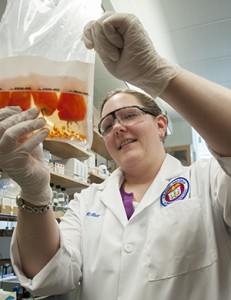
A fresh tomato is more than just a tasty addition to a sandwich or salad.
To scientists at the Food and Drug Administration (FDA), the tomato is an enigma and the focus of a group of researchers nicknamed “Team Tomato.”
The mystery of the tomato has to do with its vulnerability to contamination by Salmonella, a bacterium that is a common cause of foodborne illness.
From 1973 to 2010, there were 15 multistate outbreaks of illnesses attributed to Salmonella contamination of raw tomatoes, with 12 of these outbreaks taking place since 2000. They resulted in almost 2,000 confirmed illnesses and three deaths, with states in the eastern U.S. hardest hit.
“The conditions in which tomatoes thrive are also the conditions in which Salmonella thrive,” says Eric Brown, Ph.D., director of FDA’s Division of Microbiology. “But the tomato always presented an extra challenge because it is so short-lived. By the time it looked like contaminated tomatoes could be causing illnesses, the harvest would be gone.”
So FDA’s focus has changed over the last decade to reducing contamination early in tomato production. Says Brown, “The question was clear: What can we do to intervene and prevent this contamination from happening in the first place?”
So what does FDA do with all this information?
The agency’s tomato research is shared on an ongoing basis with industry and agricultural extension systems at the state level. Steve Rideout, Ph.D., director of Virginia Tech’s AREC, says that he and his staff exchange research findings with FDA and share that information with growers.
“There are still a lot of unknowns when it comes to contamination of tomatoes,” says Michael Mahovic, Ph.D., a consumer safety officer on FDA’s Produce Safety Staff. “But our research helps open a window.”
Findings by FDA researchers were among the building blocks of the Proposed Produce Safety Rule mandated by the FDA Food Safety Modernization Act (FSMA), Mahovic says. The proposed rule would establish science-based standards for the production and harvesting of fruits and vegetables. FSMA gave FDA a mandate to implement a system that emphasizes prevention of risks to public health.
The tomato industry has worked closely with FDA in setting its own safety standards, says David Gombas, Ph.D., senior vice president of the United Fresh Produce Association. Industry-wide safety guidelines were adopted in 2008. And in 2009, the industry issued food safety and auditing standards, commonly called the Tomato Metrics, for growers, greenhouse operators, and packers.
Mahovic says FDA used these industry standards as the basis for its own draft guidance documents in 2009 that recommended ways in which microbial food safety hazards could be reduced throughout the tomato supply chain.
Gombas says the tomato industry continues to have a close working relationship with FDA, with frequent meetings and conversations about the latest research. The industry provides FDA access to farms and crops. “We’re all working together on this,” he says.




